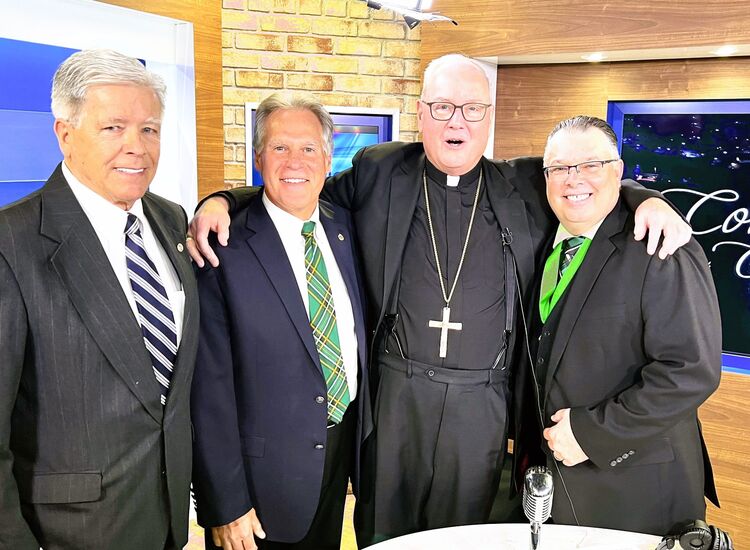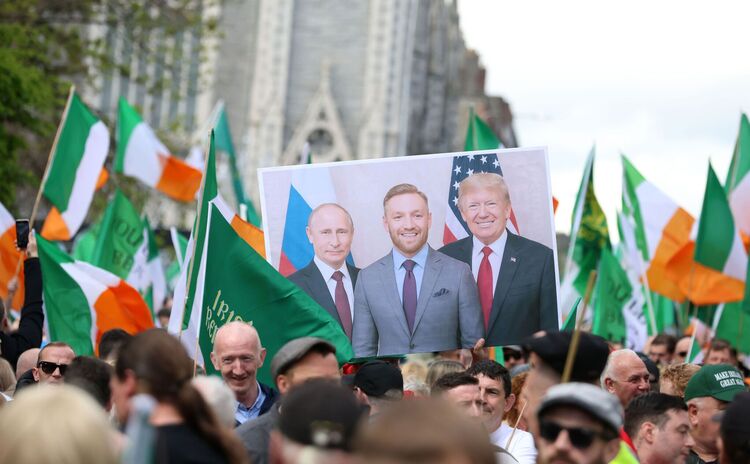Two weekends ago, the Irish Arts Center concluded its run of Mick Moloney tribute concerts. Featuring a star-studded collection of over 30 artists who came together to celebrate the leading light of Irish music in America, “A Tribute to Mick Moloney” proved an unmitigated success. It was a historic series of shows that taught people who Mick was, what his music was about, and the myriad ways he lifted people’s spirits and careers.
The evening was presented in what I would call typical Moloney style: a group of high-caliber artists (who were already mentioned in this column a couple times in recent weeks) coming together to entertain and educate. Tremendous credit for this goes to artistic directors Athena Tergis and Seamus Egan, who built a brilliant show that I think Mick really would have been proud of.
A lot can be said about this show. Every musician who paid tribute on stage described Mick’s influence from different angles and spoke of his role in their own success with gratitude and humility. The audience heard several stories about mentorship and agency. The collegial ease the performers brought made the show feel “right,” and everyone did a wonderful job to create the kind of emotional space in which our friend could be properly celebrated. This space was an intended part of the performance, of course, but it seemed to be unusually effective because the audience members I spoke with after each night’s show night all reported feeling a deep connection with the music that yielded strong feeling about Mick’s life and made the whole thing very much a healing experience.
This feeling seems to have worked both ways. I think it’s fair to say that the performers were also able to find a bit of peace. But I also noticed a couple of things that took place during the week that are worth pointing out. The first involves the sense of gravity I think everyone shared. All concerts are things to be taken seriously, but the performers here all seemed to share a sense of purpose and responsibility that made the entire week of rehearsals and performances feel very cohesive. Everyone wanted to honor Mick’s legacy as best they could and it felt as if the weight of that responsibility brought out everyone’s best
The second involved the way the show came together. While all the performers had played or danced with Mick at various points over the years, not everyone involved had necessarily played with each other before, or in many cases at all recently.
A show this large and with this much nuance can go sideways very easily, but it was clear that everyone involved had internalized sense of Mick’s artistic leadership and was using it in the service of artistic common ground. From the very earliest rehearsals, I noticed how conversations about the way things should come together on stage were very much based on the principles Mick always brought to his performances. I know that he worked very hard to get folks to internalize his ideas about performance and I think he would have been thrilled to see how central they were to this concert. It was very moving.
In the previous paragraph, I mentioned the show’s size. It takes a lot of people to bring a show like this together and it’s important to note the yeoman’s work of Aidan Connolly and Rachael Gilkey, who led the production’s success. But it wouldn’t have come together as completely were it not for the hard work of folks like Mac Smith, Manuel DaSilva, Kestrel Wolgemuth, Zohra Coday, Sam Shapiro, John Murray, Tom Rowley, Randi Rivera, Marc Critelli, Santiago Leon, Corbin Lenard, Grace Schultz and Adam Browne, all of whom had crucial roles. The marketing team for these sell out shows, which included Ciara O’Shea, Vivian Fong and Fiona Farrell and the front-of-house people included Anah Klate, Lindsey Freeman, Brian Magid, Tylene Soto, Stephen Peterson, and Michelle Bracken, all did important work, as did Laney Granito, Victoria Provost, Dennis Walls, Christine Cullen, Broderick Polanco and Paola Encarnacion who were integral parts of the production team as well. And finally, there were Pauline Turley and Barry Ó Séanáin, who did critical behind-the-scenes work that put the wind in everyone’s sails.
“A Tribute to Mick Moloney” was a beautiful moment in every way. Kudos to everyone involved for making it happen and to those who were able to come and enjoy the experience. A lot of people have asked about a video and I do believe one will be made available at some point, but I have no further details on when or how. However, I would suggest signing up to the Irish Arts Center’s mailing list at the Irish Arts Center's website here to stay abreast of any development there.
Death of Jimmy Kelly
Unfortunately, however, the weekend wasn’t without heartbreak. After the final Moloney show on Saturday, news began to spread that the great Jimmy Kelly had passed. Kelly was a Catskills legend and a real friend to musicians everywhere, including several who were featured in the tribute shows.
There’s a lot that can be said of Kelly and his influence on Irish music, especially in the Catskills. With a dapper sensibility and a gregarious spirit, he was very much the life of the music upstate. An outstanding céilí drummer whose family owned “Kelly’s Brookside” resort in East Durham, he once toured with the Tulla Céilí Band, was the longtime leader of the vaunted Galway Blazers band and, with his wife Anne, the host of “Kelly's Basement Concert Series,” which presented an exclusive selection of core traditional Irish musicians from his basement. The Catskills won’t be the same without him. Sincerest condolences to the Kelly and Leonard families and to his many, many friends, who will all miss Jimmy dearly.








